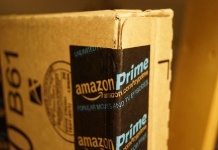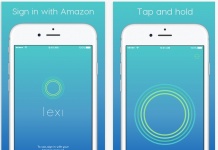 One of the great functions of science fiction is to predict the future, right? Well, chalk up another one for Vernor Vinge. The new Amazon commercial with former Top Gear host Jeremy Clarkson plays just like a scene out of his novel Rainbows End. A kid is out one soccer shoe on the day of the big match thanks to the family dog, but never fear—it’s Amazon to the rescue!
One of the great functions of science fiction is to predict the future, right? Well, chalk up another one for Vernor Vinge. The new Amazon commercial with former Top Gear host Jeremy Clarkson plays just like a scene out of his novel Rainbows End. A kid is out one soccer shoe on the day of the big match thanks to the family dog, but never fear—it’s Amazon to the rescue!
Getting the charismatic Clarkson was a master stroke for Amazon—and probably not hard, given that he’s making his new Top Gear-like show for Amazon Prime’s streaming video service with an immense budget per episode. The commercial shows off one of Amazon’s new delivery drone designs, which is still a long way from getting full regulatory approval but seems a lot closer now than when the company originally came up with the idea. This is an interesting first look at an entirely new class of drone aircraft, and possibly the first consumer “drone” that deserves the same designation as those huge things that carry out surveillance and airstrikes for the military.
This is no hobbyist quadcopter but a full-fledged industrial hybrid aircraft, capable of taking off vertically like a helicopter and flying horizontally like an airplane at speeds of up to 55 miles per hour out to a 15-mile range. (The article isn’t clear on whether that’s one-way or two-way. I assume it’s one, as it has to have enough reserve power to get back home again.) If a quadcopter is a sporty little compact car, the Amazon drone is a flying UPS truck.
And it’s not the only type of drone Amazon is designing, either. In the commercial, Clarkson says Amazon is working on a whole family of drones for different uses and situations. Presumably the one shown in the commercial is meant for long-distance rural deliveries that require speed and range. I find it hard to imagine city authorities would want something that big, heavy, and fast whizzing around their buildings.
Presumably, once Amazon can finally swing regulatory approval, Amazon Prime Now drivers will start losing their jobs. But I wonder if that’s the only effect these drones will have? After all, Amazon is known for building things to meet its own needs, then letting other businesses use them, too. That’s where Amazon Web Services came from—originally just a reliable way to run Amazon’s own web operations, it now hosts servers for a considerable chunk of the Internet (including some of Amazon’s own quasi-competitors, such as Netflix). What if a drone delivery network were to work the same way?
Imagine if you wanted to ship a package across town to someone, but needed something faster than a courier. What if you could buzz for an Amazon drone? Let it land, stick your package inside, then off it goes again to drop it off at the specified destination, for a small fee. And who knows, maybe Amazon could rent out drones for other uses, too, or sell aerial footage the drones record as they go from place to place. And how about pizza delivery? In fact, the day might come when people and businesses with special needs, such as farmers or film-makers or real estate sales firms, could buy or rent their own Amazon drones. Same for hobbyists. The commercial doesn’t explore those possibilities, but they just might be realities in the future (speculation alert—no access here to Amazon’s secret business plans).
Meanwhile it is amusing to consider that, for all that Vinge predicted the existence of package delivery drones in Rainbows End, he got one important detail wrong. It turned out not to be Federal Express who developed and operates them. And it makes sense, in retrospect. that it shouldn’t be. After all, FedEx is already tied to its own existing infrastructure, and package delivery isn’t really a growth industry. Where would FedEx find the research budget to develop an entirely new package delivery infrastructure? And why would it want to, given that the future of commercial drone use is literally up in the air right now?
But Amazon is pulling in cash like crazy, and always looking for new things to spend it on so it can expand and not show a huge profit. In a very real sense, Amazon has money to burn on this sort of thing—and it has a history of gazing into the future and then trying to make that future real. I wonder how long it will be before the first real Amazon drone delivery?

































